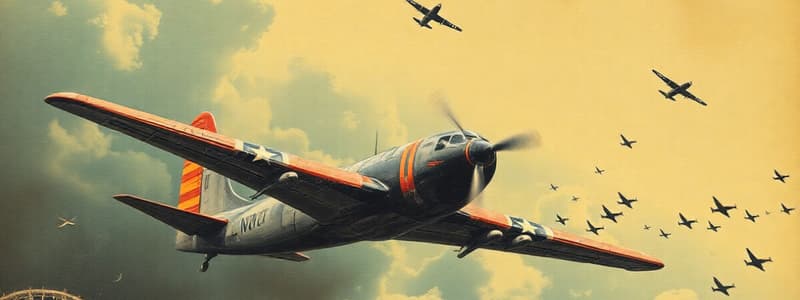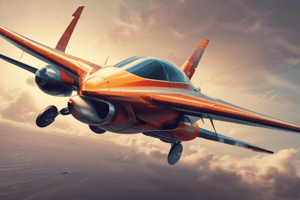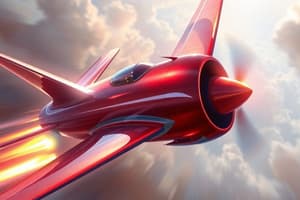Podcast
Questions and Answers
What is the primary force that counteracts the weight of an aircraft during flight?
What is the primary force that counteracts the weight of an aircraft during flight?
- Gravity
- Thrust
- Lift (correct)
- Drag
Which type of drag is specifically associated with the generation of lift?
Which type of drag is specifically associated with the generation of lift?
- Form Drag
- Surface Friction Drag
- Induced Drag (correct)
- Parasite Drag
What does Bernoulli's Principle explain in the context of aerodynamics?
What does Bernoulli's Principle explain in the context of aerodynamics?
- The relationship between pressure and velocity in a fluid (correct)
- The mechanics of drag forces
- How thrust is generated by engines
- The effects of gravity on flight
What effect does increasing the angle of attack have on lift, prior to reaching the critical point?
What effect does increasing the angle of attack have on lift, prior to reaching the critical point?
Which factor is NOT typically considered in the design of an efficient wing?
Which factor is NOT typically considered in the design of an efficient wing?
What is described by the term 'stall' in aerodynamics?
What is described by the term 'stall' in aerodynamics?
How does camber affect an aircraft's lift generation?
How does camber affect an aircraft's lift generation?
Which parameter helps predict flow patterns in fluid dynamics?
Which parameter helps predict flow patterns in fluid dynamics?
Which force produced by the aircraft engines helps maintain speed despite the resistance of drag?
Which force produced by the aircraft engines helps maintain speed despite the resistance of drag?
Why is understanding aerodynamics crucial for aircraft performance?
Why is understanding aerodynamics crucial for aircraft performance?
Flashcards are hidden until you start studying
Study Notes
Basic Aerodynamics
Key Concepts
- Aerodynamics: The study of the behavior of air as it interacts with solid objects, particularly aircraft and vehicles.
Fundamental Forces
-
Lift:
- Force that acts perpendicular to the airflow.
- Generated primarily by wings (airfoils) due to pressure differences above and below the wing.
-
Weight:
- Gravitational force acting downward on the aircraft.
- Must be countered by lift for flight.
-
Thrust:
- Forward force produced by engines.
- Overcomes drag to maintain speed.
-
Drag:
- Resistance force acting opposite to the direction of motion.
- Types:
- Parasite Drag: Caused by the shape and surface of the object.
- Induced Drag: Resulting from the generation of lift.
Bernoulli's Principle
- Describes the relationship between pressure and velocity in a fluid:
- Increased velocity = decreased pressure.
- Explains how lift is generated by airfoil shape; faster airflow over the top reduces pressure compared to slower airflow underneath.
Airfoil Design
-
Camber:
- Curvature of the airfoil.
- Affects lift generation; more camber typically increases lift.
-
Angle of Attack:
- The angle between the chord line of the wing and the oncoming airflow.
- Increased angle can increase lift up to a critical point; beyond this, stall occurs.
Flight Conditions
-
Stall:
- Loss of lift due to excessive angle of attack.
- Results in a rapid descent and potential loss of control.
-
Approach Speed:
- The speed at which an aircraft approaches landing.
- Important for maintaining lift without stalling.
Reynolds Number
- Dimensionless quantity that predicts flow patterns in different fluid flow situations.
- Influences the transition from laminar (smooth) to turbulent flow.
Practical Applications
-
Wing Design:
- Must balance lift, drag, and stability for optimal performance.
-
Aircraft Performance:
- Understanding aerodynamics is crucial for improving fuel efficiency, speed, and maneuverability.
Summary
- Aerodynamics is essential for understanding how aircraft generate lift, overcome drag, and achieve flight.
- Key forces include lift, weight, thrust, and drag, all of which interact dynamically during flight.
- Design principles from Bernoulli's principle and airflow dynamics guide the development of efficient and safe air vehicles.
Basic Aerodynamics
Key Concepts
- Aerodynamics studies air's behavior in interaction with solid objects, particularly in aviation and vehicles.
Fundamental Forces
- Lift:
- Acts perpendicular to airflow, generated by pressure differences around wings (airfoils).
- Weight:
- The downward gravitational force on the aircraft, balanced by lift for sustained flight.
- Thrust:
- Forward force from engines, needed to overcome drag for velocity maintenance.
- Drag:
- Resistance opposing motion; includes:
- Parasite Drag: Arises from an object’s shape and surface texture.
- Induced Drag: Associated with the creation of lift.
Bernoulli's Principle
- Describes pressure-velocity relationships in fluids:
- Increased airflow velocity results in decreased pressure.
- Explains lift generation as faster airflow over airfoils decreases pressure on the upper surface compared to the lower surface.
Airfoil Design
- Camber:
- The curvature of airfoils; higher camber usually enhances lift.
- Angle of Attack:
- The angle between the wing's chord line and incoming airflow.
- Increasing this angle boosts lift up to a critical limit; exceeding it leads to stalling.
Flight Conditions
- Stall:
- Occurs when lift is lost due to excessive angle of attack, causing rapid descent and potential loss of control.
- Approach Speed:
- The required speed during landing to maintain lift and avoid stalling.
Reynolds Number
- A dimensionless value that predicts fluid flow patterns, indicating transitions between laminar (smooth) and turbulent flow.
Practical Applications
- Wing Design:
- Aims to balance lift, drag, and stability for optimal aircraft performance.
- Aircraft Performance:
- Mastery of aerodynamics is vital for enhancing fuel efficiency, speed, and maneuverability.
Summary
- Understanding aerodynamics is critical for lift generation, drag overcoming, and successful flight dynamics.
- Key forces interact dynamically, influencing aircraft behavior, performance, and design based on principles such as Bernoulli’s.
Studying That Suits You
Use AI to generate personalized quizzes and flashcards to suit your learning preferences.



